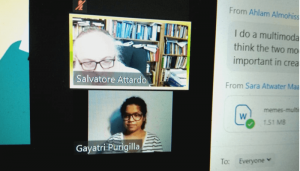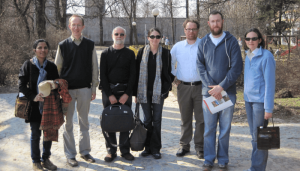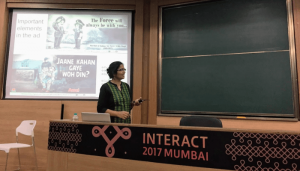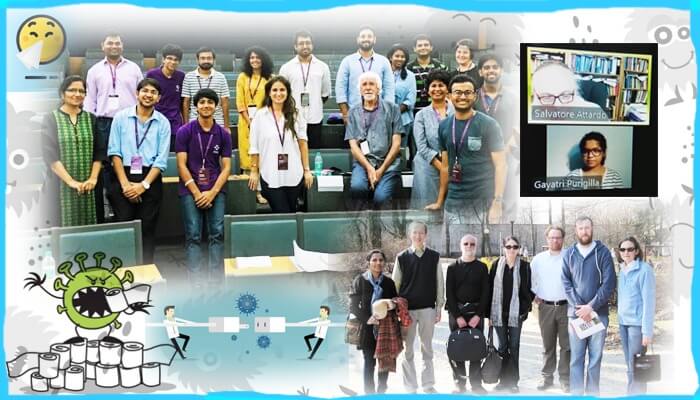On the heels of the recently concluded 11th Humour Research Conference, we find out just why humour research is not a laughing matter at the Language Technologies Research Centre (LTRC).
Joking one’s way through a crisis has long been considered a coping mechanism. Research has shown how using laughter as a stress-buster provides the much-needed diversion especially in an unchanging situation. Much like the one brought upon us by the novel Coronavirus. Social media platforms particularly saw a deluge of humorous memes, jokes, videos, GIFs, and more – all related to the universality of the pandemic.
#Covidlol
Dual Degree student Gayatri Purgilla under the guidance of Dr. Radhika Mamidi set out to analyze the type of humour that went viral at every step of the development of Covid-19. “We wanted to understand if it is possible to deduce a trending topic, either universal or culture-specific based on the humour type,” says Gayatri. For instance, when the US reported a massive shortage of toilet paper as a result of panic hoarding in early April of 2020, it led to a surfeit of jokes on the same topic. “As was the case with Dalgona coffee or Work-From-Home memes,” remarks Dr. Mamidi, explaining how the frothy concoction born out of social isolation as well as the WFH acronym earlier restricted to only a handful became a universal phenomenon. According to her, while cartoons on animals taking to the streets as humans looked on from behind grilled windows were universal, toilet paper humour is culture-specific (thanks to its deemed irrelevance in our local context) just like the summer-induced papad and pickles memes during the lockdown was specific to India.


Using data extracted from tweets, the team found that the type of humour derived out of someone’s misfortune or ‘schadenfreude’ was the most common type present irrespective of the time period. Think of the time the former US President Donald Trump and the first Lady Melanie Trump tested Covid-positive. ‘Schadenfreude’ jokes reported an all-time peak then. Also, whenever governments announced new lockdown guidelines or policies with respect to the pandemic, satire and sarcasm were the most popular humour techniques deployed. “It’s similar to cartoons that we typically see in newspapers in response to official announcements, like a petrol or an LPG price hike. Sometimes, you feel helpless and resort to humour as a coping technique,” says Dr. Mamidi. She also recalls how jokes arise during disasters or terrible times citing Auschwitz jokes that surfaced during WW II.
Humour Research through the Years
Dr Radhika Mamidi’s tryst with Humour Studies began in the early 1990s. She worked on ‘Translation of Jokes from English to Telugu’ for her MPhil thesis and realised how challenging the field was. “As a student of Linguistics, I was intrigued by humour with linguistic elements like puns that were difficult to translate,” she says. As part of her PhD work on Conversation Analysis, she analysed a classic Telugu play Kanyasulkam by Gurazada Apparao for its humour techniques. After a decade into her career as a computational linguist, her interest in Humour Studies was revived in 2010 when she came across a call for participation in the First International Symposium on Linguistic Approaches to Funniness, Amusement and Laughter (LAFAL 2010) in Poland. She presented her preliminary work there on ‘Understanding Amul Advertisements’. Amul ads known for their wit and creativity are a take on trending topics and rely on the audience’s acquaintance of both Hindi and English to understand the puns.

A deeper analysis was presented at ‘Humour in Interaction’ (HUMIC) workshop at INTERACT 2017. After networking with researchers in the field, work in humour became a hobby for Dr Radhika and she often brings in this aspect while taking classes in Pragmatics and Discourse Analysis. Soon the bug bit her students too. Srishti Aggarwal, Vikram Ahuja, Taradheesh, Vaishnavi, Gayatri and a few summer interns have been involved in Humour Analysis and Generation. As also the newly initiated Mayank Goel and Tanishq Chaudhary from UG2.

A Full Circle
Dr Mamidi feels her research as a student has now come a full circle with her students working on the same topics while using the latest NLP techniques. As a professor of computational linguistics, she now brings in machine learning into the world of semantics and linguistics of humour. For instance, Srishti worked on Amul ads and Vaishnavi is working on Kanyasulkam. To recover codemixed pun targets from Amul ads, a four-step algorithm which uses language models and phonetic similarity-based features was adopted by Srishti to get the desired results. Vaishnavi’s novel annotation schema is based on the conversational humour in Kanyasulkam in a bid to help machines capture cultural nuances of such humour. This was presented at the Linguistics Annotation Workshop (LAW) in December 2020. The hierarchical structure and techniques of humour that were generated based on this work can be extended to any domain as well as any language. Gayatri verified the schema with the Covid humorous tweets and presented her work virtually at the 11th Humour Research Conference (HRC 2021) organised by Texas A&M University.

Humour Recognition and Generation
According to the professor, there are two things that they are focussing on in computational humour: recognition of text as humorous, and automatic generation of such humorous texts. As an initial step towards humour-generation, Dr. Mamidi and Srishti first looked at simple template-based jokes and created a machine learning model that could automatically generate Door Se Dekha shayari. Admitting that this is simplistic at best, the researchers have now been trying to train systems to think like humans who can discern subtleties in complex humour. One such deep learning method developed by Vikram Ahuja tried to computationally analyse humour that was in bad taste or offensive. A hybrid-model (one that uses neural and classical approaches) proposed by Mayank Goel and Tanishq Chaudhary has resulted in not only classification of punchlines in a conversational context but also automatic generation of the same. This work was also presented by the duo at the HRC.


Witty Chatbot
With one of her research areas being Dialog Systems, Dr. Mamidi is keen to bring in humour in a chatbot. She wants to resume work that was initiated as a result of summer internships before the pandemic struck. The basic idea was to build a dialog system that not only understands humour but also makes humorous remarks. “We were thinking of sarcasm. We used IMDB database and integrated a Q&A dialogue system into it. A simple non-humorous version would retrieve the answer to ‘Who is the director of this film?’. But with the component of sarcasm inserted into it, now, if you ask “What is the name of the last film that Dev Anand acted in?”, it will not only provide the relevant answer but end it with a sarcastic quip about your purported age or remark about your taste!,” says Dr. Mamidi. Further, she opines, “Humour being the toughest area for computational intelligence to grasp, it will make Human-Computer interactions much more natural and interesting. With humour enabled, the machines will be more human-like”.



Next post